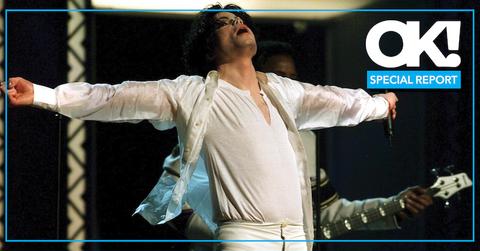 NEWS
NEWSThe Truth About Michael Jackson's Death: Inside The Late Singer's Downfall

Dec. 9 2022, Published 8:00 a.m. ET
It was a bizarre scene. When paramedic and firefighter Richard Senneff responded to a 911 call and arrived at the rented home of Michael Jackson on June 25, 2009, he found the pop star unresponsive in his bed, surrounded by oxygen tanks and IVs. Conrad Murray, Michael’s private doctor, frantically tried to revive the singer before he was taken to Cedars-Sinai Medical Center, where he was pronounced dead after suffering a cardiac arrest.
His bedside table was littered with prescription medicine bottles, and the room was reportedly littered with medical paraphernalia, including latex gloves, drug vials and syringes. The King of Pop was dead at age 50. More shocking, his death was officially ruled a homicide: The medical examiner determined that a lethal cocktail of prescription medications — including the anesthetic propofol, which had been administered by Dr. Murray — had caused the heart attack.
Two years later, Dr. Murray was convicted of involuntary manslaughter and sentenced to four years in prison (he served two). But doctors and those who were close to Michael know that’s not the whole story — and they’re finally telling all. “It’s a lot more complicated than just: Dr. Murray was at his bedside when he died,” says LAPD detective Orlando Martinez in the TMZ documentary series, Who Killed Michael Jackson? A source told Star, “Michael was dancing with death for a long time before he died.”
The trouble began in 1984, when Michael suffered severe burns when pyrotechnics on the set of a Pepsi commercial ignited his hair. The painkillers he was prescribed to help him bear the second-degree burns marked the beginning of his spiral into addiction. He later said he became “increasingly more dependent” on them while touring. Meanwhile, he was one of the most recognizable people on the planet, selling more than 750 million records worldwide, which made feeding his growing habit increasingly difficult. Ultimately he created 19 fake aliases so he could illicitly collect piles of drugs. His plastic surgeon, Dr. Harry Glassman, has said the star resorted to “doctor shopping." An autopsy later revealed Michael’s emaciated body was riddled with needle marks likely from drug use, and he weighed just 112 pounds.

According to the assistant chief coroner for L.A. County, Ed Winter, Michael was taking propofol in “Gatorade”-size bottles. “[It] was the only way he could go to sleep, especially when he was getting ready for a tour,” said Dr. Murray. No one knows how much agony Michael was in before he died — it’s a secret he took to the grave.
“He was a tortured soul,” says the source. “He kept so much from everyone.”
His addictions took a massive toll. The source says family members and close friends tried to intervene as the superstar became more frail and isolated. “I brought it up with him many times,” friend Deepak Chopra, has said, adding, “It was an addiction that was created and perpetuated by doctors.”

Powered by RedCircle
Yet, during his tragic final days, the former child star was planning a triumphant comeback with the This Is It tour. It was more than just a career move. At the time, he was in debt to the tune of $500 million — he was reportedly spending $35 million a year on his lavish lifestyle — and was desperate to make money and repair his image, which had been tarnished by child molestation charges, his obsession with plastic surgery and other bizarre behavior. The night before he died, the “Bad” singer stunned onlookers by appearing like his old self during a six-hour dress rehearsal.
But choreographer Kenny Ortega was still worried. “There are strong signs of paranoia, anxiety and obsessive-like behavior,” he wrote at the time.
The source says he was particularly terrified his kids (he welcomed son Bigi, 20, via surrogate in 2002) would be kidnapped, disguising them with masks when they went out. But the children saw a Michael no one else knew. “They hero-worshipped him as a dad,” says the source.
“He was so loving and sensitive to their needs and always there for them.” They are determined to keep his memory alive. As Paris has said, “He was the best father you could ever imagine.”

